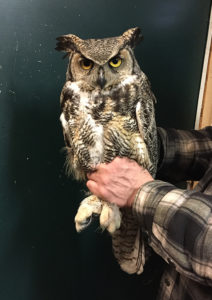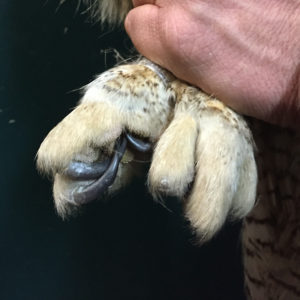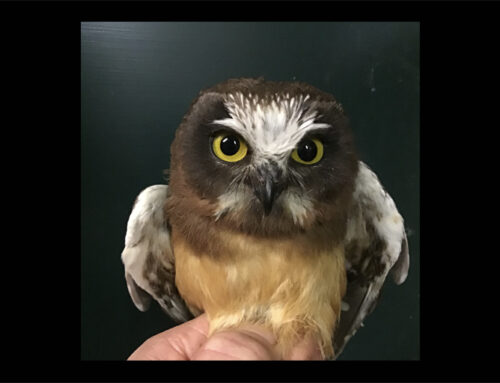The recent nights have regularly been filled with hoots, honks, howls, wing-claps, wing-twitterings, and peents as spring continues to return to the Point a bit early this year. The owl migration has produced a bit of a mixed bag since our last post. Species diversity has been good, but the Northern Saw-whet Owl numbers have been lower than those we saw earlier in the season. Adding to the diversity of last week was the arrival of the first Great Horned Owl of the season. We don’t band Great Horned Owls every year; we don’t even see them at the Point every year. Nothing snaps us to attention more than suddenly seeing a Great Horned Owl in the net as we prepare to get control of the feet before the feet get control of us. The Boreal Owls have remained steady in low numbers, and the Long-eared Owls have picked up a little. We’re particularly excited for the long-eareds this year, as we are collecting some additional data for a Northern Michigan University grad student’s project. Working on her project has already taught us new things about long-eareds. So far this season, we have banded 133 Northern Saw-whet Owls, 12 Boreal Owls, 23 Long-eared Owls, and one Great Horned Owl. We have also recaptured nine saw-whets and one boreal.
We very rarely recapture Boreal Owls, I think this is only the second that we have personally recaptured. Like the first one, this one had been banded at WPBO the previous fall. Tori Steely and Zach Wilkinson banded this one last October on its first fall migration. They only banded six Boreal Owls last fall, so it is pretty amazing that we recaptured one. As we mentioned in a previous post, although some owls do not survive through the winter and migration, the owls have been in great shape this spring. This young Boreal Owl was a perfect example of that, as it had increased its weight by 40% since last October! It was very impressive to see her bulging muscles and fat stores, and so cool to be able to compare her current weight with what it was in October.

The Boreal Owl recapture. You can’t tell, but under those beautiful feathers, she is bulging with muscle and fat.

The season’s first, and possibly only Great Horned Owl.

The Great Horned Owl’s feet.
The owl banding regularly provides us with opportunities to see things that are typically difficult to see in the field. One of our absolute favorite things is the fuzziness of Boreal Owl feet. Boreals come to the U.P. to escape winter, and they don’t even come this far south every year. Their legs and feet have such fluffy feathers for warmth that it is hard not to call them furry. Their feet also have variable amounts of dark speckling that we love. The below composite photo shows a Boreal Owl on the left and a Northern Saw-whet Owl on the right. Saw-whets and boreals are closely related, so you can see how much more adapted boreals are to handle cold weather.

The feet of a Boreal Owl (left) and a Northern Saw-whet Owl (right).
Chris Neri & Nova Mackentley
WPBO Spring Owl Banders
If you are considering visiting the Point, please read this important message from Michigan Audubon and WPBO Field Staff.
Maneuvering the ever-changing implications of COVID-19 has necessitated constant adaptation and evaluation for us all. Michigan Audubon and WPBO have been proactive in taking measures that protect our staff, our physical community in Paradise, and the Michigan birding community, and we have found American Birding Association’s recent guidelines on birding and social distancing a useful resource for guiding bird-related travel decisions. While there are hopeful signs that we are rounding the corner with this virus, Michigan Audubon does not want to sow precocious optimism that encourages long-distance travel. Please take a minute to read these ABA guidelines, and to imagine them through the lens of the eastern Upper Peninsula, which does not have the medical resources of Michigan’s more-developed areas. Chippewa County and its adjacent counties have just three hospitals, and only one of these has more than 100 beds; they all are at least an hour’s drive from the Point. WPBO appreciates and requests your continued conscientiousness as the season’s migration begins to ramp up, and does not condone birding travel that is not local. Keep in mind that the Owl’s Roost Gift Shop and public observation of owl banding are currently closed. In the meantime, we will virtually share the Point with you as best we can until it is safe for all parties to enjoy it together. We hope that will be soon.



